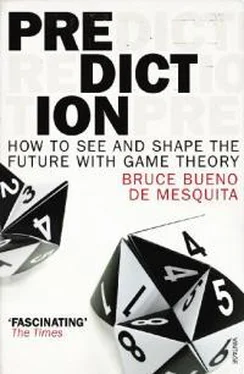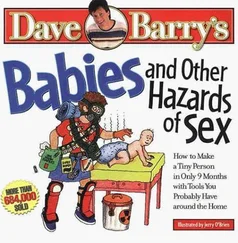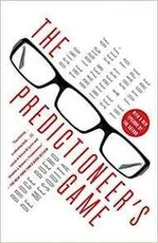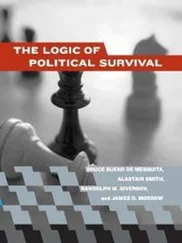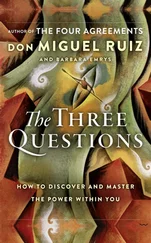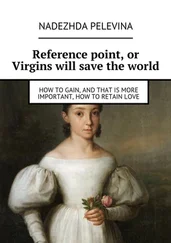What was surprising, and distressing, was the pattern of evolving power among the national leadership that emerged from the analysis. While capturing the conventional wisdom about the relative power of the PPP and the PML-N, they also found a solid answer to a pressing question. Many Pakistan watchers speculated on whether the new leadership in the National Assembly would make a deal with hard-liners. None, as far as I know, had dared to quantify what that might mean in terms of the future distribution of political power in Pakistan and its implications for shaping policy.
The predictions my students made, based on game-theory logic and the data they amassed to seed the model, can be seen in the figures that follow. The first addresses Musharraf’s potential to survive the election’s outcome and the conditions that ultimately would lead to his ouster. At the time their study was done, I think it is safe to say, most people believed Musharraf was finished. A few speculated on whether the United States would somehow save him, but most thought he would be political history right after the February 2008 election. “Not so fast,” said my students’ results.
Figure 10.1, on the next page, tells the story of what could have been and of what was to be. If the two parties in the government, Zardari’s PPP and Sharif’s PML-N, had been willing to work together, then figure 10.1 shows us that Musharraf could indeed have been ousted in March or April 2008, just as the pundits expected. The government parties’ combined power—the heavy solid line in figure 10.1—overtakes Musharraf in the period between March and April. That would have been the opportunity to kick him out, as expected by most Pakistan watchers. But the model tells us that the PPP and PML-N were not willing to work together at that time. The model shows that Sharif believed throughout this period that he could pressure Zardari and his party into doing just what Sharif wanted. The model also tells us that Sharif was wrong. According to the model’s results, Zardari saw no reason to listen to Sharif since the PPP had substantially more clout than Sharif’s PML-N. As we know now, rather than work together, Sharif threatened to withdraw his support for the government in May 2008, because Zardari was unwilling to commit to deposing Musharraf.
FIG. 10.1. How Long Could Musharraf Be Tolerated?
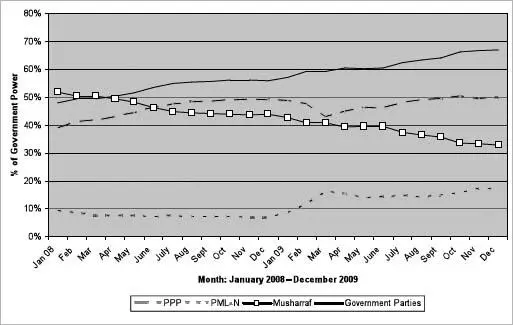
But figure 10.1 tells a more complete story than just that. We can also see that the model projected that Zardari’s PPP (the dashed line in the figure) on its own, without help from Sharif, would surpass the declining Musharraf in power by June or July 2008. At that point, the PPP didn’t need anyone’s help to dump Musharraf. They had the clout to do it on their own. (We now know that they in fact did push him out in August 2008 and that Zardari assumed Musharraf’s role as Pakistan’s president.)
So while the world’s media were counting Musharraf out in February, the students successfully forecast that the divide between the PML-N and the PPP would allow Musharraf to hang on for about six months past when they began their study. But even this is but a small part of the big emerging story played out in advance by modeling key Pakistani policy issues. Figure 10.1 compares the power of only three of many players in Pakistan’s political game. Let’s see what the picture looks like when we throw in the main potential threats to Pakistan’s civil, secular government. I have in mind al-Qaeda, the Pakistani and Afghani Taliban, and even Pakistan’s military, with its long history of coups against civilian governments.
Figure 10.2 tells an incredibly distressing story for any who hold out hope for stable democracy in Pakistan. Pakistan’s Taliban and their Afghan compatriots work together as one, so I present them as if they are one. Looked at this way, they are far and away the most powerful force within Pakistan. And al-Qaeda is next in line according to the model, at least after April 2008, when their power is projected to surpass the government’s. Al-Qaeda just continues to grow and grow. Together with the Taliban they constitute the emerging dominant source of political influence in Pakistan, with only outside influencers like the United States or the Europeans being possible counterweights. Remember, we are plotting power—political influence weighted by salience—based on information known (or at least estimated by my students) back in January 2008 and not after. Yet here is the headline from the New York Times lead story on June 30, 2008, months after the analysis was done: “Amid U.S. Policy Disputes, Qaeda Grows in Pakistan.” The story goes on to say “it is increasingly clear that the Bush administration will leave office with Al Qaeda having successfully relocated its base from Afghanistan to Pakistan’s tribal areas, where it has rebuilt much of its ability to attack from the region and broadcast its messages to militants across the world.” My students were able to foresee this troubling prospect half a year ahead of the New York Times . Maybe they could have done so even earlier; remember, they only assembled their data in January 2008, when the course, Solving Foreign Crises, began. They saw this result immediately.
FIG. 10.2. Who Will Have the Clout in Pakistan?
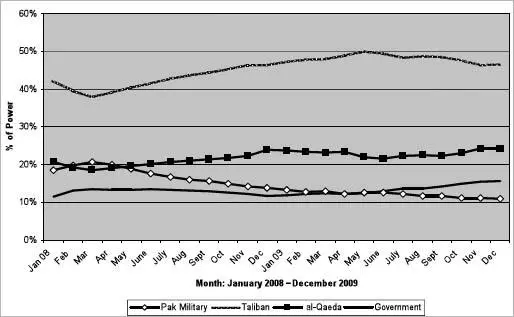
There is one other troubling feature to figure 10.2. Other parts of the model’s output tell us that al-Qaeda and the Taliban will try to negotiate an arrangement with the PPP and the PML-N. Sharif’s PML-N is modestly more open to such talks than is Zardari’s PPP. Both prefer to live with the existing status quo vis-à-vis the militant groups while trying to consolidate their own hold on power. In the meantime, the Pakistani military sees itself slowly but steadily losing influence. Such a circumstance raises the prospect that they will try to stem the tide against them by launching a coup to take control of the government. The optimal period for them to take such a step is projected to be between February 2009 and July 2009. Earlier than that they see no need, and later may be too late for them. Pakistan’s fragile democracy appears likely to be under assault from the militants who would establish a nondemocratic fundamentalist regime on one side, and from the army that would establish a military government on the other.
What does this mean about Pakistan’s contribution to the war on terror? Will they make a more vigorous effort to pursue militants and stamp them out, or will the Pakistani government succumb to the projected growing influence of al-Qaeda and the Taliban? I think you can guess the answer. But just in case you can’t, figure 10.3 tells that story.
The status quo commitment to go after al-Qaeda and the Taliban back when my students began their project was at 40 on their issue scale. A value of 40 meant some real efforts to contain the militants but falling well short of trying to stamp them out as the United States wanted. That was equivalent to a score of 100 on the scale. The status quo, with some erosion, was close to the policy predicted to hold, more or less, until the summer of 2008. A position of 0—al-Qaeda’s position (not shown)—meant “Do nothing against the militants.” With that in mind, let’s see what we predict for the future.
FIG. 10.3. Who Will Urge Pakistan’s Pursuit of Internal Militant Groups?

Читать дальше
